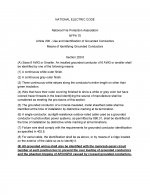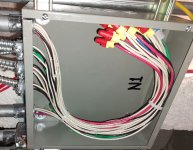Alexis
Member
- Location
- Los Angeles
Hello,
I tried searching, but couldn't find clear answer to my question. Often when we update/upgrade panels we find multiple wires from one conduit where we have to identify multiwire circuits to have them ziptied (neutral and 2 hots) and have a common trip breaker installed. So far most of the cases I had to trace the whole conduit to the next jbox and find where the wiring is going which is very time consuming.
Does anyone know any easier way of locating the pairs and their neutrals? Of course if I see romex 12-3 or 14-3 that is easy. But when there is a conduit with 15 wires (lets say 10 black and 5 white ones) it becomes a bit of a problem..
Thank you!
I tried searching, but couldn't find clear answer to my question. Often when we update/upgrade panels we find multiple wires from one conduit where we have to identify multiwire circuits to have them ziptied (neutral and 2 hots) and have a common trip breaker installed. So far most of the cases I had to trace the whole conduit to the next jbox and find where the wiring is going which is very time consuming.
Does anyone know any easier way of locating the pairs and their neutrals? Of course if I see romex 12-3 or 14-3 that is easy. But when there is a conduit with 15 wires (lets say 10 black and 5 white ones) it becomes a bit of a problem..
Thank you!



